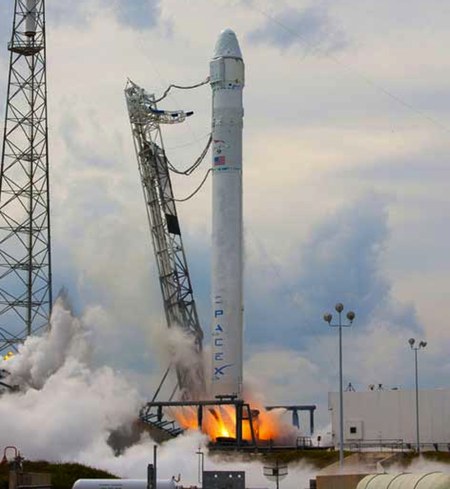
The Falcon 9 carrying the Dragon spacecraft for the CRS-2 mission undergoes a hot fire test on the pad on Monday, February 25. (credit: SpaceX)
SpaceX is on track to launch this Friday the second of 12 contracted cargo missions to the International Space Station (ISS). Launch of the Dragon spacecraft atop a Falcon 9 rocket on a mission the company designates CRS-2 is scheduled for 10:10 am EST (1510 GMT) from Cape Canaveral. NASA and SpaceX officials indicated all was going well with the launch preparations, and there is an 80% chance of acceptable weather for the launch.
During a preflight press conference Thursday afternoon, SpaceX president Gwynne Shotwell provided some new details about the previous Falcon 9 launch, of the CRS-1 mission, in October. That launch suffered a shutdown of one of its nine first stage engines; the Dragon spacecraft still reached orbit although a second payload, a demonstration satellite for commercial communications company ORBCOMM, was placed in a lower-than-planned orbit to comply with NASA mission rules, and deorbited a few days later. Back in December Shotwell said the investigation into the engine anomaly was wrapping up, but offered few details about the incident.
On Thursday, Shotwell went into a little more detail. “There was a material flaw that went undetected in the jacket of the Merlin engine, resulting in a breach during the flight, causing depressurization of the combustion chamber,” she said. “The flight computer recognized that depressurization and commanded a shutdown.”
Shotwell did not go into more detail about the nature of the anomaly, saying that a detailed report about it was being reviewed by the State Department for public release in order to comply with export control laws. Engine technology is particularly sensitive, she said, and thus the company is being very conservative in what it says while awaiting approval of the report. “We’re just ultra-sensitive about that. I don’t look good in horizontal stripes. I certainly don’t want to go to jail,” she said.
This mission, like the last, is carrying a relatively light load: 677 kilograms of pressurized cargo (primarily experiments and related equipment) and 373 kilograms of unpressurized cargo up to the station, and 1,370 kilograms of cargo back from the ISS. Prior to the CRS-1 flight, which also had a light load, NASA and SpaceX officials said they were limited by volume, not mass. (Dragon is designed to carry up to 6,000 kilograms up to the station and up to 3,000 kilograms back.)
However, at Thursday’s press conference, Shotwell indicated that they were near the limits of the performance of the current, and soon to be replaced, version of the Falcon 9. “The upgraded Falcon 9 launch vehicle will accommodate a dramatic increase in cargo,” she said, referring to the “v1.1″ version of the Falcon 9, whose first flight in planned for. “You will see an increased amount of cargo both due to probably NASA comfort with our maturity in getting to space station, in addition, the upgraded Falcon 9 allows for additional carriage of cargo.”
Shotwell also briefly addressed another topic at the press conference unrelated to the CRS-2 mission: the announcement this week by the Inspiration Mars Foundation, established by businessman and space tourist Dennis Tito, to launch a human Mars flyby mission in 2018. SpaceX had been wrapped up in the news because a paper about the proposed mission used the company’s Dragon and Falcon Heavy vehicles as its baseline. So far, though, Shotwell said the company has no relationship with Inspiration Mars, confirming what those involved with the project said earlier this week. “I think his plan is very ambitious,” she said. “If he can come up with the funding to execute this mission, I’d be happy to have him as a customer.”

Leave a Reply